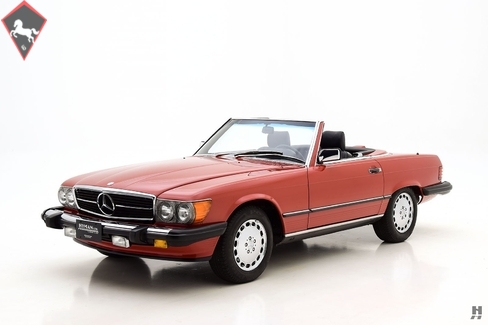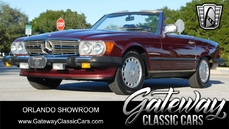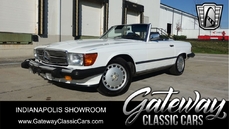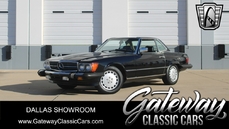Mercedes-Benz 560SL w107 Convertible 1987
General description :
Following the commercial success of the R113-series 230, 250 and 280SL, Mercedes-Benz realized they had a tough act to follow with its replacement. The R113 SL models were responsible for perfecting Mercedes’ formula for their ideal sports roadster. The 300SL was a technological marvel, but costly to build, buy and maintain. The 190SL utilized humble passenger car architecture in a pretty body, but was perhaps a bit too pedestrian in terms of performance. The 230SL fixed that with its fuel-injected six cylinder engine and well-honed chassis that borrowed much from other cars in the Mercedes lineup, though with better resolved handling and far better performance. The R113 was continuously improved through the 1971 280SL, the car’s focus being less overtly sporty than its rivals, yet still enormously capable as a comfortable and imminently stylish grand tourer.
Mercedes-Benz understood the importance of this new SL roadster, and they threw all they had been studying in the previous decade into the project, with the first examples hitting the road in late 1971. Stuttgart engineers had become obsessed with safety and with the idea of overbuilding their cars. Every surface of the new car, internally known as R107, was carefully honed for maximum safety. Even the signature ribbed tail lights are a result of safety studies, engineers found they stayed cleaner and therefore more visible in poor weather conditions. In spite of the obsession for safety, the R107 wore sophisticated and elegantly styled bodywork with traditional long-bonnet, short-deck proportions. Like other SLs before it, the new car was available with a removable hard top for all-weather enjoyment. Architecture followed the established SL ethos, borrowing from other mid-sized Mercedes cars for suspension and drivetrain, but fine tuning the handling for a more sporting feel. The 107 was produced from 1971-1989; the Mercedes second-longest running model in the marque’s history, and in the process earning its place as an iconic status symbol of the 1980s.
Our featured car is the ultimate model of the R107 range, a 560SL from 1987. For this, the final iteration of the series, engineers shoehorned the big 5.6 liter V8 engine and automatic transmission from the 560SEL sedan, creating the fastest and arguably most desirable model of the line. Nearly two decades of development meant the 560SL still felt fresh and benefitted from an impressive equipment list that included ABS brakes, limited slip differential, and a driver’s side airbag. This fine example has covered a genuine 28,395 miles from new and presents in excellent condition throughout. The Signal Red paint (code 5680) is excellent and looks great against the original bright-finish wheels. The body is exceptionally straight, showing no signs of accidents or corrosion, which is backed by a clean Carfax report. It wears its original hardtop and black German canvas soft-top, both in excellent condition. A hard top stand for easy, safe storage will be included in the sale. The chrome bumpers are straight and clean, with the front bumper wearing original Bosch fog lamps.
The Anthracite leather interior (code 271) is consistent with the rest of the car, being exceptionally clean and original with excellent seats, door panels and carpets. The dash is crack-free and the wood trim intact and free from cracked lacquer or delamination. Even the delicate wood strips on the fascia are in excellent condition. The interior is completely stock down to the original airbag steering wheel, Becker Grand Prix radio and optional central arm rest. Likewise, the trunk is tidy and clean with factory correct carpeting and panels. Original books, tools and jack are included.
The 5.6 liter V8 engine is very nicely detailed, appearing clean and tidy with signs of regular maintenance. The factory finishes on the hardware and ancillaries remain in great condition, indicative of this car’s very low mileage. A stack of records and receipts, as well as the comprehensive Carfax report, show this car received plenty of routine maintenance in the hands of its last owners. This is an excellent example of what is considered to be the most desirable of the R107 series. These rapidly appreciating classics are excellent all-rounders, combining iconic good looks with exceptional reliability, vault-like build quality and surprising performance.
https://hymanltd.com/vehicles/5958
1987 Mercedes-Benz 560SL w107 Convertible is listed sold on ClassicDigest in St. Louis by Mark Hyman for $47500.
Car Facts
Car type : Car Make : Mercedes-Benz Model : 560SL w107 Model Version : Convertible Engine size : 0.0 Model Year : 1987 Sub type : Convertible Location : Missouri
Sold
Seller Information
Sold
People who viewed this Mercedes-Benz 560SL w107 also viewed similar Mercedes-Benz listed at ClassicDigest
Other cars listed for sale by this dealer
About Mercedes-Benz
In the annals of automotive history, the journey of Mercedes-Benz is a tale that unfolds with the ingenuity of its founding pioneers. In the year 1886, Karl Benz crafted the Benz Patent Motorwagen, a creation that would go down in history as the world's inaugural automobile. Unbeknownst to him, this moment marked the genesis of what would evolve into the most illustrious premium car manufacturer globally. The financial underpinning of this pioneering venture, interestingly, was provided by Karl Benz's wife, Bertha Benz, demonstrating a remarkable partnership that would set the tone for Mercedes-Benz's legacy.A parallel narrative emerged not far away, as Daimler-Motoren-Gesellschaft, founded by Gottlieb Daimler and Wilhelm Maybach, entered the scene. In 1901, they unveiled their automobile under the now-famous moniker "Mercedes," meaning "godsend" in Spanish. This name was bestowed upon the car at the behest of Emil Jellinek's daughter, the distributor for Daimler-Motoren-Gesellschaft. The wheels of innovation were set in motion.
Fast forward to 1926, a pivotal year that witnessed the merger of Daimler with Benz & Cie., culminating in the birth of Daimler-Benz. The amalgamation saw the adoption of "Mercedes-Benz" as the distinguished trademark for their automobiles, fusing the legacies of two visionary entities into one.
Contrary to perceptions of conservatism, the trajectory of Daimler-Benz unfolds as a chronicle of industry firsts. From the introduction of the honeycomb radiator to the float carburetor, and the pioneering implementation of four-wheel brakes in 1924, Daimler-Benz consistently pushed the boundaries of automotive innovation. The diesel-powered Mercedes-Benz 260 D in 1936 marked the inception of diesel engines in passenger cars. The iconic Mercedes-Benz 300SL Gullwing made history as the first car with direct fuel injection, albeit the Gutbrod's tiny 2-stroke engine can claim precedence.
Safety innovations became a hallmark, with Béla Barényi's patented safety cell design in the "Ponton"-models in 1951, featuring front and rear crumple zones. The W116 450SEL 6.9 saw the introduction of the Anti-Lock Brake system (ABS), another pioneering safety feature. From the first production airbags and beyond, the legacy of "firsts" continued to be etched into the fabric of Daimler-Benz.
Over its centennial journey, Mercedes-Benz has not merely produced cars but has sculpted automotive icons. The SSKL, 710 SSK Trossi Roadster, 770K Grosser, 540K Spezial Roadster, 300SL Gullwing, w100 600 Pullman, w111 280SE 3.5 Flachkühler, w113 230SL Pagoda, w109 300 SEL 6.3, and w201 2.3-16 Cosworth stand testament to the brand's commitment to engineering excellence.
The roaring Silver Arrows, or "Silberpfeile," including the W 25, W 125, W154, W165, and W196, created a legacy of dominance on the racetrack. These machines were not merely cars; they were expressions of precision, speed, and an indomitable spirit that left their competitors in the dust.
As Mercedes-Benz marches into the future, it does so not just as an automaker but as a custodian of a legacy, a torchbearer of innovation, and a beacon of automotive excellence. The road ahead is sure to witness the continued fusion of cutting-edge technology, timeless design, and an unwavering commitment to setting new standards in the world of automobiles.
One luminary figure who left an indelible mark was Béla Barényi, often heralded as the "father of passive safety" for his pioneering work in safety engineering. His patented safety cell design, featuring front and rear crumple zones, became a hallmark of Mercedes-Benz's commitment to occupant safety, setting new standards that reverberated throughout the automotive world.
Moving through the chronicles, the collaborative genius of Wilhelm Maybach, alongside Gottlieb Daimler, laid the foundation for Daimler-Motoren-Gesellschaft. Their innovations not only birthed the first Mercedes but established a culture of relentless pursuit of technological excellence that remains integral to Mercedes-Benz's DNA.
In the post-merger era of 1926, Ferdinand Porsche emerged as a prominent figure within Mercedes-Benz. His work on the Mercedes-Benz S-Type, a supercharged race car, garnered acclaim and set the stage for a legacy that extended far beyond the marque. Porsche's impact would later extend to his eponymous company, but his influence at Mercedes-Benz during those formative years was pivotal.
As the 20th century progressed, the legendary Rudolf Uhlenhaut emerged as a key figure. Uhlenhaut, an accomplished engineer and the driving force behind the iconic Silver Arrows, played a crucial role in Mercedes-Benz's dominance in motorsports. His engineering prowess and attention to detail were instrumental in creating some of the most formidable racing cars of the era.
In the latter half of the century, figures like Bruno Sacco, the head of design at Mercedes-Benz from 1975 to 1999, left an indelible imprint on the brand's aesthetic identity. Sacco's design philosophy, characterized by clean lines and timeless elegance, shaped iconic models like the W126 S-Class and the W201 190E, solidifying Mercedes-Benz's reputation for luxury and sophistication.
The narrative would be incomplete without acknowledging the contributions of engineers like Hans Scherenberg, whose leadership in the 1970s ushered in a new era of technological innovation at Mercedes-Benz. Scherenberg's tenure saw the development of groundbreaking technologies, including the Anti-Lock Brake system (ABS) and the introduction of airbags in production cars.











